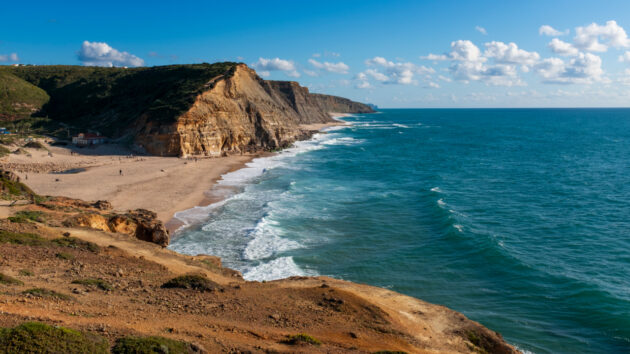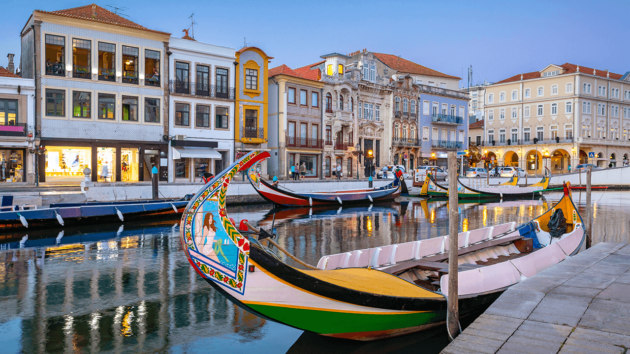
When someone moves to a new country they will try to find out as much as they can about their new home, from the lifestyle to tax issues and transports. Then they also have to choose where to live. In this article we describe the regions of Portugal and tell you what each one has to offer.
North
The north has so much to offer: landscapes, flavours and places to visit. The most well-known city is Porto, but there are plenty of others to choose from. Just across the Douro River is Vila Nova de Gaia, a place of stark contrasts, with both river and sea, and a must for anyone who wants to visit the Port Wine cellars.
Further north, in the Minho region, you can find Braga, known for its historical links to Catholicism and its religious heritage and events, or Guimarães, the city most closely associated to the founding and identity of Portugal. Finally, there is Viana do Castelo, where you will find one of the most beautiful and well preserved historical centres in the country.
On the other hand, there is Bragança, in Trás-os-Montes, with its shale villages and cross-border natural park, the ancient Vila Real, with its aristocratic houses or Chaves, an historic city where you can find traces of human occupation from the Palaeolithic days.
This is a great region for hiking, with plenty of monuments and parks to visit. So, if you do decide to move to the north and want to take advantage of your time to see the sights, make sure you don’t miss the Casa da Música and the Clérigos Tower, in Porto, the Castle in Guimarães or the Bom Jesus Shrine in Braga.
The North is served by the Porto airport, which has flights to and from Paris, London, Rome or Berlin. As for real estate, the price per square meter is €892, lower than the centre, for instance. However, there are important variations between the coast and the interior. A house in Porto, for example, is more expensive than in Bragança.
>Real estate price per m2: €892*
>Unemployment rate: 7,2%*
>Main universities: Universidade do Minho, Universidade do Porto, Universidade Católica Portuguesa, Instituto Universitário da Maia, Instituto Politécnico do Porto, Universidade de Trás-os-Montes e Alto Douro, Instituto Politécnico do Cávado e do Ave, Instituto Politécnico de Bragança.
*Source: INE, 2st trimester 2019
Centre
In central Portugal you’ll find the highest point of mainland Portugal, the oldest university and the biggest waves in the world. There are several good cities to live in such as Aveiro, known for its estuary and traditional moliceiro boats, or Coimbra, a city that revolves around the university and student traditions, which is an excellent choice for studying in Portugal.
You can also opt for Viseu, an important reference in terms of religious art and architecture, or Leiria, with its rivers, beaches, forest, lagoon, museums and medieval buildings. Another alternative is to settle in Castelo Branco, capital of the Beira Baixa region, with its rare balance of past and present, or Guarda, the country’s most elevated city, located 1056 meters above sea level in the Estrela mountains, with a panoramic view over the surrounding landscape.
Here in Central Portugal you will also find several UNESCO World Heritage sites, such as the Convento de Cristo, in Tomar, the Batalha monastery and Coimbra University, the oldest in the country, founded in 1290.
At 1993 meters above sea level, the Torre, atop the Estrela Mountain, which spans the districts of Guarda and Castelo Branco, is the highest point of mainland Portugal. But if you prefer the beach, then you can’t go wrong with Peniche and Nazaré, in Leiria. These are fishing cities, with great beaches for surfing or other water activities.
This region has the second lowest price per square meter in mainland Portugal, which can be an important factor when choosing where to settle. It also includes some of the best universities in the country, which is an advantage if you have school aged children.
>Real estate price per m2: €747*
>Unemployment rate: 5,3%*
>Main universities: Universidade de Aveiro, Universidade da Beira Interior, Universidade de Coimbra, Instituto Politécnico de Coimbra, Instituto Politécnico da Guarda, Universidade Católica Portuguesa, Instituto Politécnico de Leiria
*Source: INE, 2st trimester 2019
Lisbon Metropolitan Area
The Lisbon Metropolitan Area includes Greater Lisbon and the Setúbal Peninsula, for a total of 18 councils and over two and a half million residents. It includes the portuguese capital, which makes it the best place for work and business opportunities.
Depending on your preferences, there is plenty to choose from. Sintra, for example, is a town which rests at the bottom of the Sintra hill, filled with estates and palaces. The setting is almost idyllic, but also full of opportunities if you have your heart set on the tourism sector. Mafra, on the other hand, which lies on the outskirts of Lisbon, is known for its imposing palatial convent.
If you prefer the beach, and also want to escape the bustle of the centre of the capital, Cascais, Sesimbra or Ericeira are good choices, as is Oeiras or other locations near Lisbon.
When it comes to real-estate, the average price per square meter is very high, surpassed only by the Algarve. Besides this, if you need to be near your native city, the Capital has the largest airport in the country, with daily flights to some of the main destinations in the world, such as London, Paris, Berlin, Amsterdam, Rio de Janeiro or New York.
> Real estate price per m2: €1383*
> Unemployment rate: 7,2%*
>Main universities: Universidade de Lisboa, Universidade Nova de Lisboa, Instituto Politécnico de Lisboa, Universidade Católica Portuguesa, ISCTE – Instituto Universitário de Lisboa, Universidade Europeia, Universidade Lusófona, Universidade Lusíada, Instituto Politécnico de Setúbal
*Source: INE, 2st trimester 2019
Alentejo
With its endless plains and wild beaches, the Alentejo is the place to be if you want to live away from the confusion of the big cities.
Here you will find a unique cuisine. Enjoy the bread, the fine wines, the pork and the olive oil, and make sure to taste the famous açorda. The Alentejo is full of history, with several historical and cultural sites which have been distinguished by UNESCO.
Elvas, for instance, has some of the most well preserved fortifications in the world and Évora, with its five millennia of history are both world heritage sites. Besides this, the traditional cante alentejano music has been considered Intangible World Heritage and the cowbell manufacture technique is intangible world heritage in urgent need of safeguarding.
Beja, a peaceful and welcoming city with a walled centre and picturesque squares, is also worth considering, as are Portalegre, located at the point where the dry and flat Alentejo and the wetter more mountainous Beiras meet and Santarém, known for its agriculture, cattle rearing and bullfighting culture.
Closer to the sea, the almost untouched beaches are a unique spot. Porto Covo and Vila Nova de Milfontes, for instance, which are part of the Southeast Alentejo and Vicentine Coast Natural Park, are excellent choices for settling down, given their increasing supply of lodgings and commerce which have fortunately left the traditional design of the buildings, framed by the vast ocean, intact.
This is where you’ll find the lowest real estate prices in Portugal, at an average of €663 per square meter. Depending on which part of the Alentejo you choose, the closest airport can be Lisbon or the Algarve. The University of Évora is one of the most renowned in the country.
> Real estate price per m2: €663*
> Unemployment rate: 6,9%*
> Universities: Universidade de Évora, Instituto Politécnico de Beja, Instituto Politécnico de Portalegre
*Source: INE, 2st trimester 2019
Algarve
Known mostly as a tourist spot, the Algarve is also one of the most popular destinations for foreigners who come to live in Portugal. Over 77 thousand have chosen the Algarve, second only to Lisbon. The temperatures are mild all year and one of the main attractions is the sheer number of sunny days.
Hidden behind the walls of the Old City, the main city in the Algarve is Faro, the gateway to the south, because of the largest airport in the region. Nonetheless, the areas which attract most foreigners are Albufeira, the old fishing village which has become a very popular tourist destination, Loulé, a city with historical traces of the Arab civilisation, and Portimão, with a history of seafaring people and important fishing ports.
The western coast, known as the Vicentine Coast, is the best preserved coastline in Europe. There is great fresh fish everywhere and in terms of leisure golf rules. The region has been voted the best golfing destination in the world on more than one occasion, and boasts dozens of courses.
There is one caveat: the real estate prices are the highest in mainland Portugal, although the average is inflated by the coastal area, where most of the foreigners live. In Albufeira, for example, the price per square meter is €1821 but in Monchique, further inland, it drops to €574. The region is served by the Faro airport.
> Real estate price per m2: €1606*
> Unemployment rate: 5,3%*
> University: Universidade do Algarve
*Source: INE, 2st trimester 2019
Madeira
The main islands in the Madeira archipelago are Madeira and Porto Santo. The largest city, which is also the regional capital, is Funchal, on the Madeira Island.
With mild temperatures all year the high point of the region is New Year’s, with its unique fireworks display. The Flower Festival, held after Easter, is also a defining moment in Madeira culture.
The cuisine has several specialities. Why not try some blackscabbard fish fillets, or the beef laurel wood skewer? And don’t forget the traditional bolo do caco, a typical regional wheat bread which is delicious with garlic butter.
As for natural beauties, pride of place has to go to the Madeira Natural Park, with the largest area of Laurissilva Forest in Macaronesia, which is considered World Heritage by UNESCO. The average price of real estate is above €1000 euros per square meter. However, this is clearly influenced by the prices in Funchal, which average €1558.
> Real estate price per m2: €1205*
> Unemployment rate: 8,3%*
> Universities: Universidade da Madeira
*Source: INE, 2st trimester 2019
Azores
The archipelago of the Azores lies in the middle of the Atlantic, almost 1500 km from the coast of mainland Portugal, and just under 4000 km from New York.
The archipelago is made up of nine islands, divided into three groups: Eastern, Central and Western. The Eastern group has two islands: Santa Maria and São Miguel, which is the biggest of the archipelago. The central group is formed by five islands (Terceira, São Jorge, Pico, Faial and Graciosa) and, finally, the last two islands of Flores and Corvo are part of the Western group.
The highlights of São Miguel are the Lagoa das Sete Cidades, known for the fact that the water appears to have two colours, and the Lagoa do Fogo. The island’s cuisine is known for the famous Cozido das Furnas, which is cooked underground.
The historical centre of the city of Angra do Heroísmo, in Terceira, has been UNESCO World Heritage since 1983. And if the Estrela Mountain is the highest point of mainland Portugal, the Pico Mountain, that gives the island of Pico its name, is the highest in all of Portugal, at 2351 meters.
The only international airport on the Island is in Ponta Delgada (São Miguel) which receives flights from airlines such as TAP, Sata, Tui, Ryanair and Delta. There are international flights to Amsterdam, Boston, Brussels, Frankfurt, Las Palmas, London (Gatwick and Stansted), Manchester, Montreal, Munich, New York (JFK), Praia, Providence and Toronto. In the other islands there are airports which connect to the mainland and others which only have flights between the islands themselves.
> Real estate price per m2: €771*
> Unemployment rate: 8,2%*
> University: Universidade dos Açores
*Source: INE, 2st trimester 2019
Liked them all? No worries
If you liked them all, rest assured that you can visit them easily, regardless of where you decide to live. The country is relatively small and, therefore, distances are short. You can drive from Lisbon to Porto in around three hours and it will take you around five from Coimbra to the Algarve. So no matter where you decide to live, all the rest are within travelling distance. Only the Azores and Madeira require air travel.



